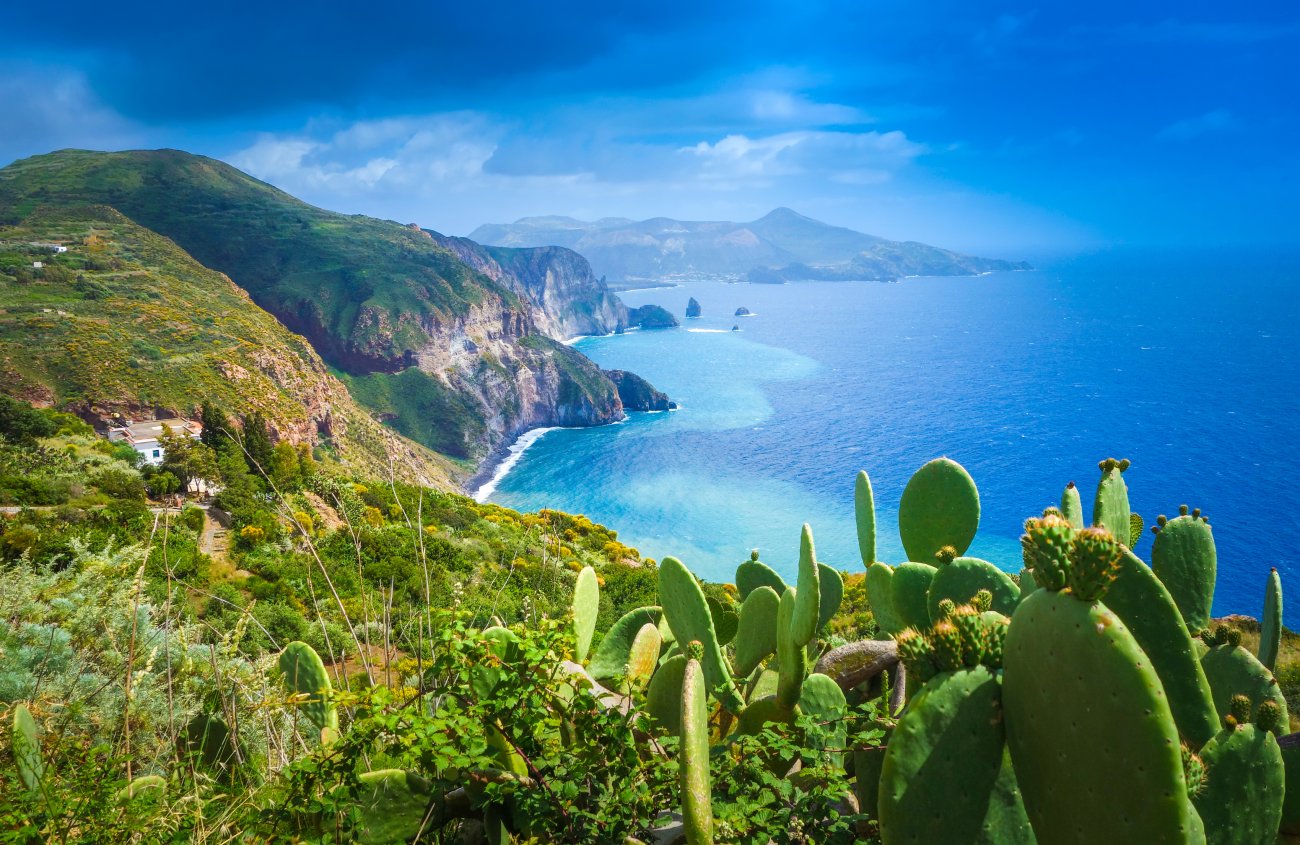
The Aeolian archipelago, surrounded by a clear blue sea, is composed of seven enchanting islands - Lipari, Panarea, Vulcano, Stromboli, Salina, Alicudi, and Filicudi, in addition to some islets, and two active volcanoes on the islands of the same names; Stromboli and Vulcano. Lipari, the largest, is a highly visited place during the summer months, while Panarea, the smallest, is also the most popular among the global elite. However, a relaxed and noise-free lifestyle prevails on all the islands, characterizing this UNESCO World Heritage archipelago.
Departing from Capo D'Orlando or Portorosa Marina heading towards the island of Vulcano, Gelso bay. A bay that seems frozen in time, with a black beach and crystal-clear purple waters, wild nature made up of prickly pears, caper plants, and wild goats that like to approach the water. The island is formed by four volcanoes, of which only one is active, its last eruption was in 1888 and lasted four years. There are still manifestations of volcanic nature. On the island of Vulcano, you have the opportunity to bathe in the famous "Pozza" thermal pool a few steps from the harbor, constantly fed by bubbles that emit sulfur vapors, brackish water, and clay mud.
Today we head towards Lipari, the largest of the seven Aeolian islands. To the south of the island, towards the channel that separates Lipari from Vulcano, two rock giants called Faraglione emerge. In the capital, also named Lipari, there is a castle surrounded by defensive walls and flanked by the districts of Marina Corta and Marina Grande. The Norman cathedral and the Archaeological Museum also deserve a visit. As on other Aeolian islands, in Lipari, you can also enjoy special and delicious desserts like cannoli with sweet ricotta. Those who enjoy nightlife will be able to attend concerts, folklore shows, and theater festivals on summer nights.
Just 9 miles from Lipari is Panarea, an exclusive and avant-garde destination, with white and blue streets, where the international elite gathers each year. At the southern end of the island, on the promontory of Punta Milazzese, a Bronze Age prehistoric village was discovered. In Panarea, one of the most evocative beaches of Sicily is found: Cala Junco, a paradise of blue and crystal-clear waters ideal for snorkeling. This beach is characterized by its amphitheater shape, bordered by rock formations that, together with the seabed and the action of the sun's rays, give the sea splendid shades. The water varies from deep blue to emerald green. Panarea is the smallest of the Aeolian Islands but is truly unique in terms of charm and beauty. You can take pleasant walks among hibiscuses, caper plants, and bougainvilleas, overlooking the splendid islets that frame it: Basiluzzo, Dattilo, Bottaro, Lisca Bianca, Lisca Nera, Formiche, Panarelli, and, in the distance, Stromboli. After spending a beautiful day enjoying one of the most beautiful seas in Italy, you can enjoy an aperitif on the terraces of the Hotel Raya and then let yourself be carried away by the night dance that will continue until late at night.
We continue the route and arrive at Stromboli, 12 nautical miles from Panarea. The island, immersed in colors and smells unique in the world, is characterized by high cliffs interrupted by small black sand beaches alternated with inlets and caves, by the white Mediterranean houses, the green of palm trees, olives, and citrus that rest on a rough but fascinating volcanic cone. The crater's explosions have been one of the most well-known lighthouses since time immemorial for anyone sailing the Tyrrhenian Sea. One of the most fascinating phenomena of the island is the Sciara del Fuoco, a stream of lava flowing into the sea. These volcanic explosions with projections of incandescent lapilli that light up the red sky occur all year round and never disappoint. It is possible to climb to the top of the crater (about a 3-hour hike) to see the continuous explosions. It is advisable to go with a guide. Stromboli is also characterized by its picturesque villages that invite you to stroll in an absolutely evocative atmosphere.
From Stromboli, we reach at Salina, where the splendid bay of Pollara is located, perfect for a pleasant swim and a good lunch. The beach, made up of large stones, is the place where some scenes from "Il Postino" were filmed. Right near the Pollara beach is Le Balate, one of the must-visit destinations in the area. In the evening, you can visit the picturesque villages of Santa Marina and Lingua, where you can taste the best "granites" of the Aeolias. The island is famous for the production of excellent local wines, such as Malvasia, and it is possible to organize visits and tastings at the wineries. Around Salina, it is easy to encounter cetaceans, dolphins, and turtles.
To conclude this beautiful journey... Filicudi and Alicudi, the wild heart of the Aeolians. Even today, these islands are considered remote, even by the inhabitants of Lipari. What makes them feel distant is not so much the distance but something deeper: it's a distance in time, in the way of being of the island and its people, a removal from the common world. Stops for swimming before and after lunch at the most characteristic points of these wonderful islands, with a visit to the impressive Grotta del Bue Marino, with its incredibly blue waters. The sound of the waves and the whisper of the wind in the vegetation are the only sounds you'll hear in Alicudi. Given the particular conformation of the terrain, there are no roads or paths, so there are no cars, motorcycles, or bicycles. To face the volcanic stone stairs found everywhere, one relies on their own feet and the friendly donkeys or mules raised on the island, which carry the weight of goods and luggage from the port to the scattered houses on the slope.